Every homeowner hits that crossroads: should I take this on myself or just hire a professional? The answer’s rarely black and white. It really comes down to your skills, your schedule, and honestly, how complicated the project looks.
Remember to repin your favorite images!
Making the right call between DIY and hiring a pro can save you a ton of time, money, and headaches later.
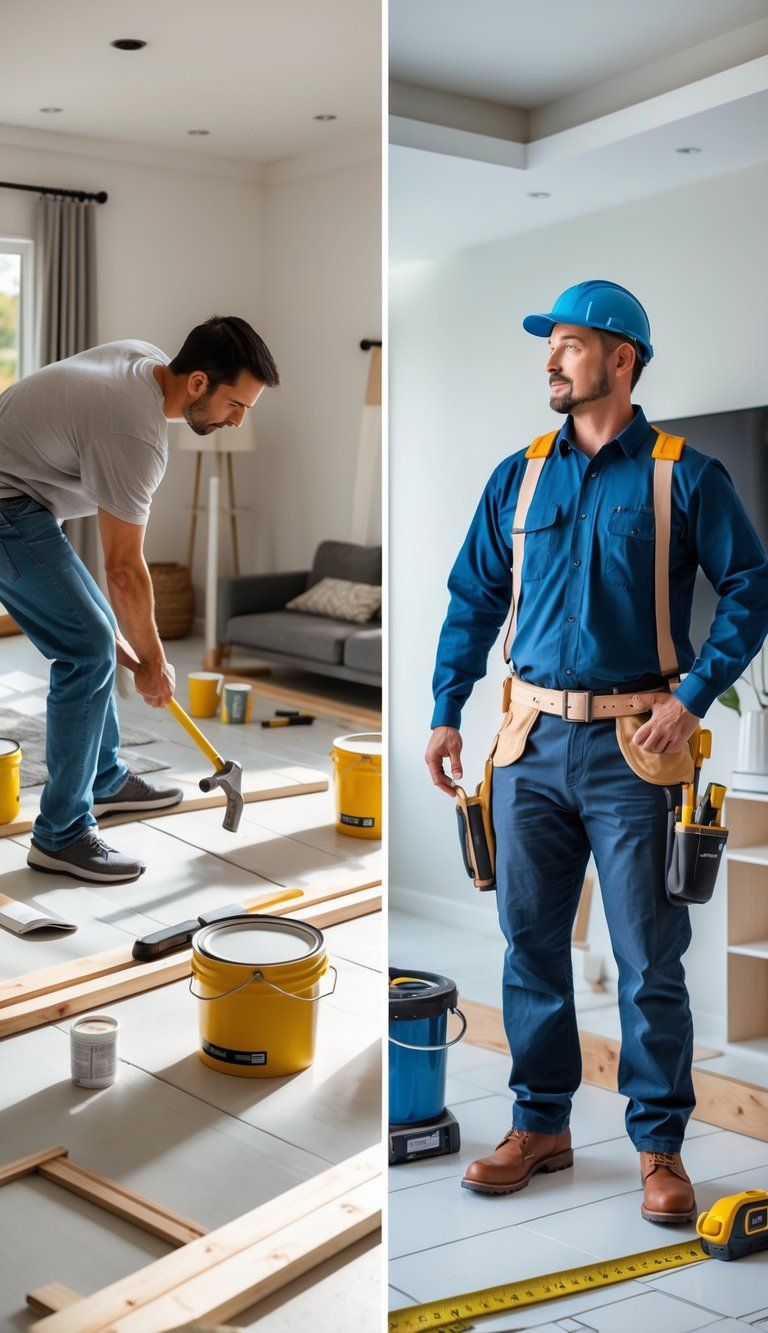
Home projects come in all shapes and sizes.
If you’re looking at simple jobs like painting a room or putting up shelves, those are solid DIY opportunities that can save cash and feel pretty rewarding. But when electrical, plumbing, or anything structural gets involved, you’re better off calling in professional expertise to keep things safe and up to code.
Think about both the upfront cost and the long-term value. DIY might look cheaper, but mistakes can get expensive fast. Pros cost more at first, but they bring experience and usually get things done faster and better.
Your budget, your confidence with tools, and how important the project is—these should all help you decide whether you’re rolling up your sleeves or making a call.
Understanding DIY and Professional Services
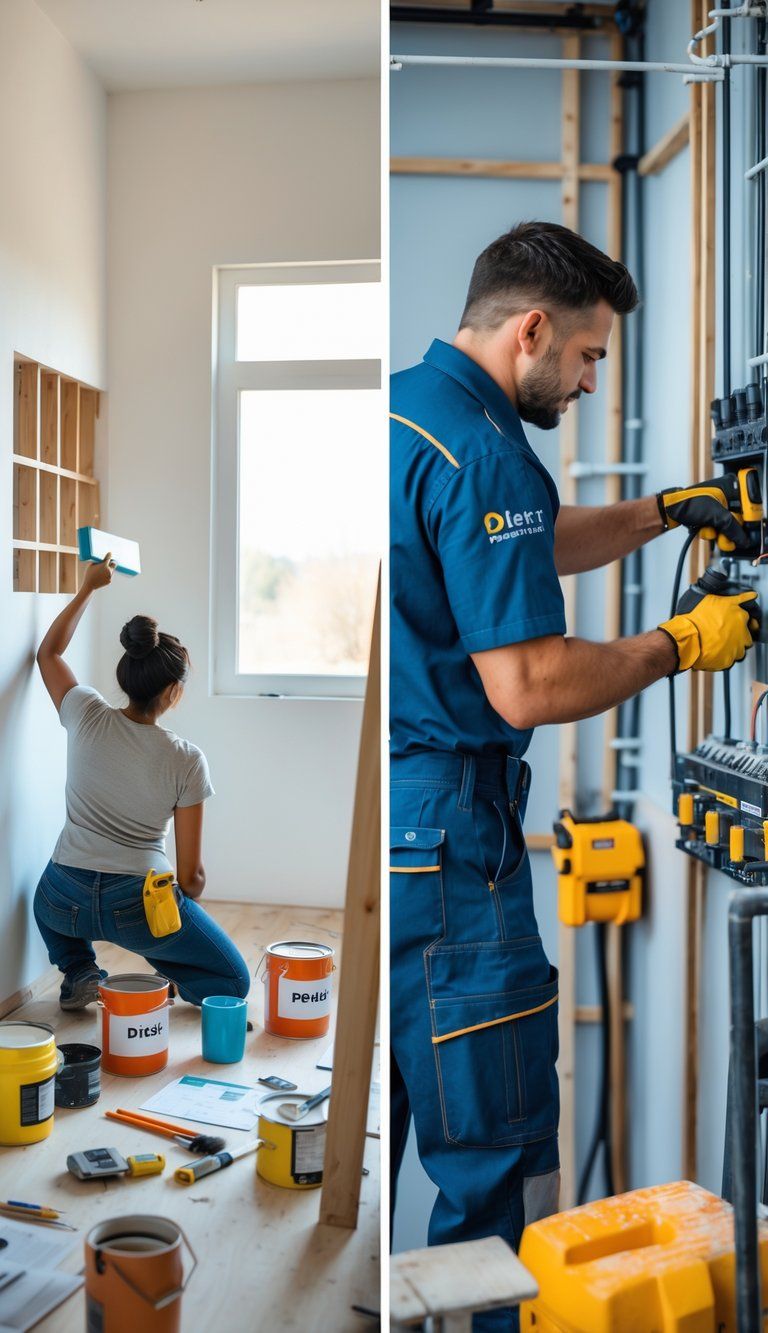
Before you start a home project, it helps to understand what DIY really means versus hiring a pro. These choices impact your wallet, your time, and how things turn out.
What Is DIY?
DIY (Do-It-Yourself) is just what it sounds like—you handle everything. You plan, buy the stuff, and do the work.
People love DIY for a few reasons:
- Saving on labor
- That feeling of accomplishment
- Picking up new skills
- Working when you want, not waiting on someone else
DIY does ask for patience and sometimes tools you might not own. It’s smart to start small, like fixing a wobbly shelf or patching a hole, before jumping into bigger stuff.
What Does Hiring a Pro Involve?
Hiring a professional means you pay someone with specialized training to handle the project. This could be a handyman or a licensed contractor, depending on the job.
When you hire a pro, you’re really paying for:
- Their expertise
- Work done right, with fewer slip-ups
- Your own free time
- Permits and code compliance handled
- Warranties on their work
Usually, you’ll get a few estimates, check out reviews or references, and sign a contract that covers the details. It’s pricier, but you often get better finishes and sometimes a boost in home value.
A lot of folks mix it up—DIY for the small stuff, pros for anything big, tricky, or risky.
Evaluating Your Skills and Capabilities

Before you dive in, take a real look at what you can handle. Your past experience, how quickly you pick things up, and what tools you actually have will shape whether DIY makes sense or if you should bring in a pro.
Assessing Your Experience
Think back—have you done something similar before? Maybe you’ve laid tile or painted a few rooms already.
Be honest with yourself. If your shelves always end up slanted or your paint jobs turn out patchy, that’s probably a sign to call for help on bigger projects.
Ask yourself, “What’s the worst that could happen?” Some mistakes are minor and fixable. Others, like botched wiring, could turn into a real hazard, while a painting mistake just means another coat.
Learning Curve and New Skills
How much time do you want to spend learning? Some projects are great for skill-building and can come in handy later.
You can find tons of tutorials online, or even take a workshop at a hardware store. But let’s be real—a five-minute video isn’t the same as years of hands-on training.
Projects like plumbing, electrical, or anything structural usually have a steeper learning curve. The risks can be much higher, too.
Learning something new feels great, but weigh that against how much time and money you might lose if things go sideways.
Access to Tools and Equipment
Check your toolbox. Do you have what you need? Basic jobs use hammers and screwdrivers, but bigger projects might need specialized gear.
Ask yourself:
- Do I already have the right tools?
- Is it worth buying or renting something I’ll only use once?
- Where will I even store this stuff?
- Can I use it safely?
Renting can save you money for one-off projects. If renting tools costs close to half of what a pro charges for labor, you might as well hire out.
Professionals show up with the right tools and the know-how to use them. Their gear often does a better job than what you’ll find at a big box store.
Project Complexity and Risk Assessment

Knowing how tricky—or risky—a project is helps you figure out if you should DIY or call in the pros. A little upfront thinking can save you a lot of grief.
Identifying Simple vs. Complex Tasks
Simple DIY jobs stick to basic skills and don’t need much special knowledge. Think:
- Painting walls or furniture
- Putting together furniture from a box
- Hanging shelves or hooks
- Basic yard work
- Unclogging a straightforward drain
Complex projects usually need training, special tools, or even permits. According to surveys, around 30% of DIY projects go off the rails because people misjudge the complexity. These include:
- Electrical wiring that’s more than just swapping fixtures
- Major plumbing (beyond a leaky faucet)
- Changing walls or anything structural
- Roof work
- Installing or fixing HVAC systems
If you run into hidden stuff—like water damage under tiles—you’ll probably need a pro.
Assessing the Risk and Safety Hazards
Safety comes first, always. Ask yourself:
- Could I get hurt if this goes wrong?
- Do I need special safety gear?
- Am I dealing with anything hazardous?
High-risk jobs include:
- Electrical work—Shocks, fire, code problems
- Gas lines—Leaks or worse
- Structural changes—Collapse or damage
- Roofing—Falls, leaks
Even trimming trees can get dangerous without the right tools or experience. Sometimes, the cost of safety gear or a trip to the ER is way more than just hiring someone.
Time Commitment Considerations
DIY almost always takes longer than you think, especially if you’re new to it. A pro might finish in a few hours what could take you days.
Keep in mind:
- Learning takes time
- You might need to hunt down tools
- Mistakes happen
- You could end up redoing things
That weekend painting project? It might drag on for weeks once you factor in prep, learning, and cleanup.
Your time matters, too. Figure out your “DIY hourly rate” by dividing your savings by how many hours you’ll spend. For big, tough projects, it’s often not worth it.
Budgeting: When to Save and When to Splurge

Making smart money moves with home projects is all about knowing where your dollars really count. Sometimes it’s worth spending more, sometimes not so much.
Understanding Hidden Expenses
A lot of projects come with sneaky costs. Planning a kitchen renovation? Remember, installation labor can add up to half the total cost.
Always add at least 15-20% extra for surprises. You never know when you’ll find water damage or old wiring.
Tools add up, too. Buying a tile saw for $200 when you could rent one for $40? Not the best move unless you’ll use it again.
Permits and inspections aren’t optional for big jobs. Skipping them can get expensive fast, so check with your city before you start.
Evaluating Long-Term Value
Some upgrades pay off more than others. Durable flooring in busy areas means fewer replacements. Spending extra on solid hardwood in the living room makes sense, but in the basement, luxury vinyl will do.
Energy-efficient windows cost more up front, but can cut your heating and cooling bills by up to 25%. Usually, you’ll break even in about 5-7 years.
Good plumbing fixtures are worth it. A $150 faucet with ceramic disc valves could last 15 years or more, while a $50 one might leak in a year or two.
Think about resale, too. Kitchen and bathroom upgrades often return 60-80% of what you spend when you sell.
Warranties and Guarantees
Check warranties before you buy anything big. Some “lifetime” deals only cover the first owner or have weird fine print.
Higher-end appliances usually have better warranties. For example, a good dishwasher might have five years of parts coverage, while a cheap one offers just a year.
If you get something installed by a pro, sometimes that extends the warranty. Flooring companies, for example, often want certified installers or the warranty’s void.
Keep all your receipts and paperwork together—snap photos and email them to yourself just in case.
For pricey items, think about extended warranties. They’re usually worth it for stuff with electronics or moving parts that would cost a lot to fix.
Home Improvement Projects Best Suited for DIY
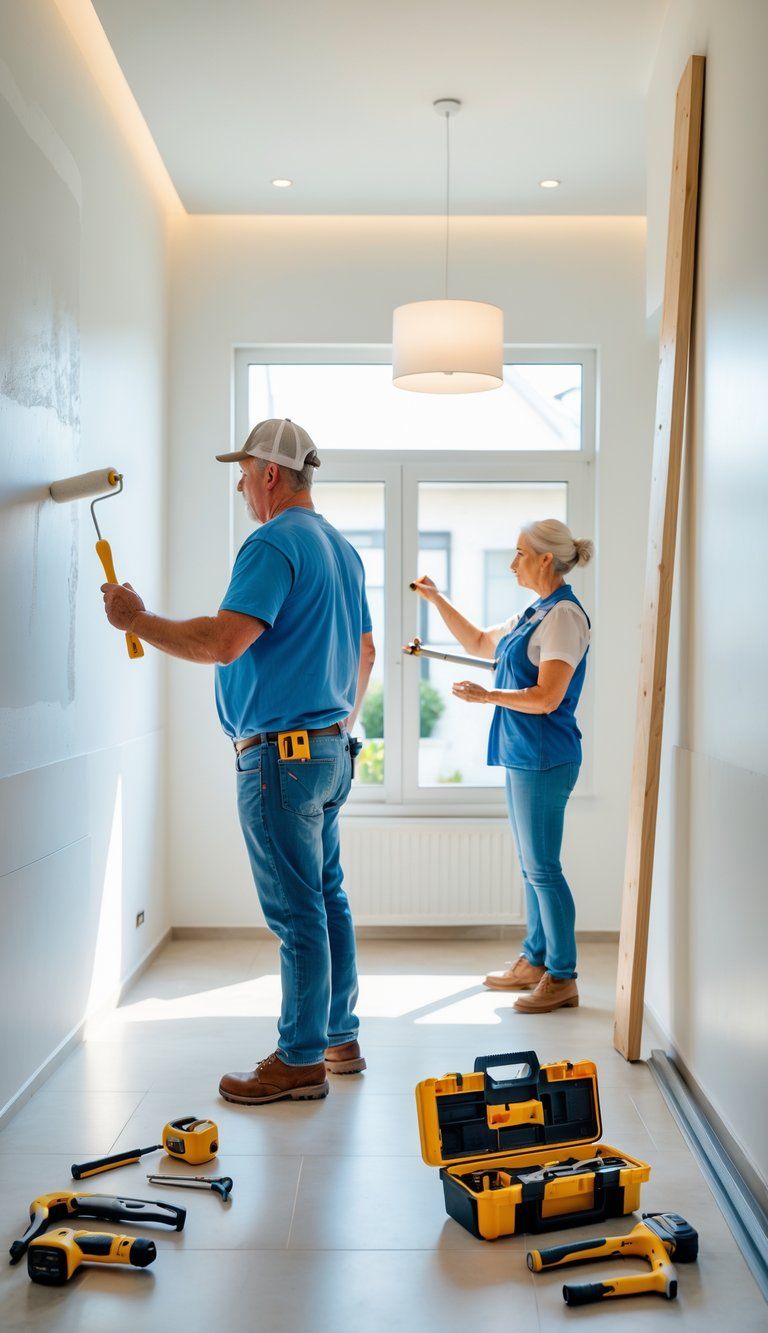
You don’t need to call in the pros for every home project. Plenty of jobs are perfect for a DIYer who wants to save money and add a personal touch.
Painting and Decorating
Painting is hands-down one of the easiest and most satisfying DIY projects. A fresh coat can transform a room for the price of a few supplies.
You’ll need:
- Paint
- Brushes and rollers
- Painter’s tape
- Drop cloths
Prep makes a big difference. Clean the walls, tape off your trim, and use a primer if you’re covering dark colors or stains.
DIYers also love projects like hanging shelves, putting up artwork, or using peel-and-stick wallpaper for an accent wall. You usually only need a few tools, and you can finish most of these in a weekend.
Minor Repairs and Caulking
You can handle small repairs around the house without much fuss. Fixing a leaky faucet, swapping out cabinet hardware, or patching little holes in drywall? Just grab some basic tools and check out a few online tutorials.
Caulking, in particular, is a great place to start if you’re new to DIY. Fresh caulk in the bathroom or kitchen not only tidies up the look, but it also keeps water from sneaking in where it shouldn’t.
Here’s how I usually tackle caulking:
- Pull out all the old caulk
- Wipe the area clean
- Squeeze out a steady bead of new caulk
- Run a wet finger or a caulk tool along the line to smooth it
Swapping out switch plates, doorknobs, or drawer pulls is another quick fix that really freshens up a room. It’s surprising how much of a difference these small changes make.
Simple Landscaping Projects
You don’t need a pro to give your yard a boost. Basic landscaping—like planting flower beds, spreading mulch, or laying down a simple garden path—can make a big impact and is totally doable over a weekend.
Some easy outdoor upgrades you might want to try:
- Add solar-powered path lights
- Build a raised garden bed
- Plant some shrubs or perennials
- Lay mulch borders around your trees
Seasonal chores like pruning shrubs or planting annuals can save you a good chunk of change compared to hiring landscapers. If you don’t want to dig up the yard, try container gardening on your patio or deck. It’s an easy way to add some green without much hassle.
Before you buy any plants, double-check what actually grows well in your climate. No one wants to see their new garden wither away.
Projects That Require Professional Expertise
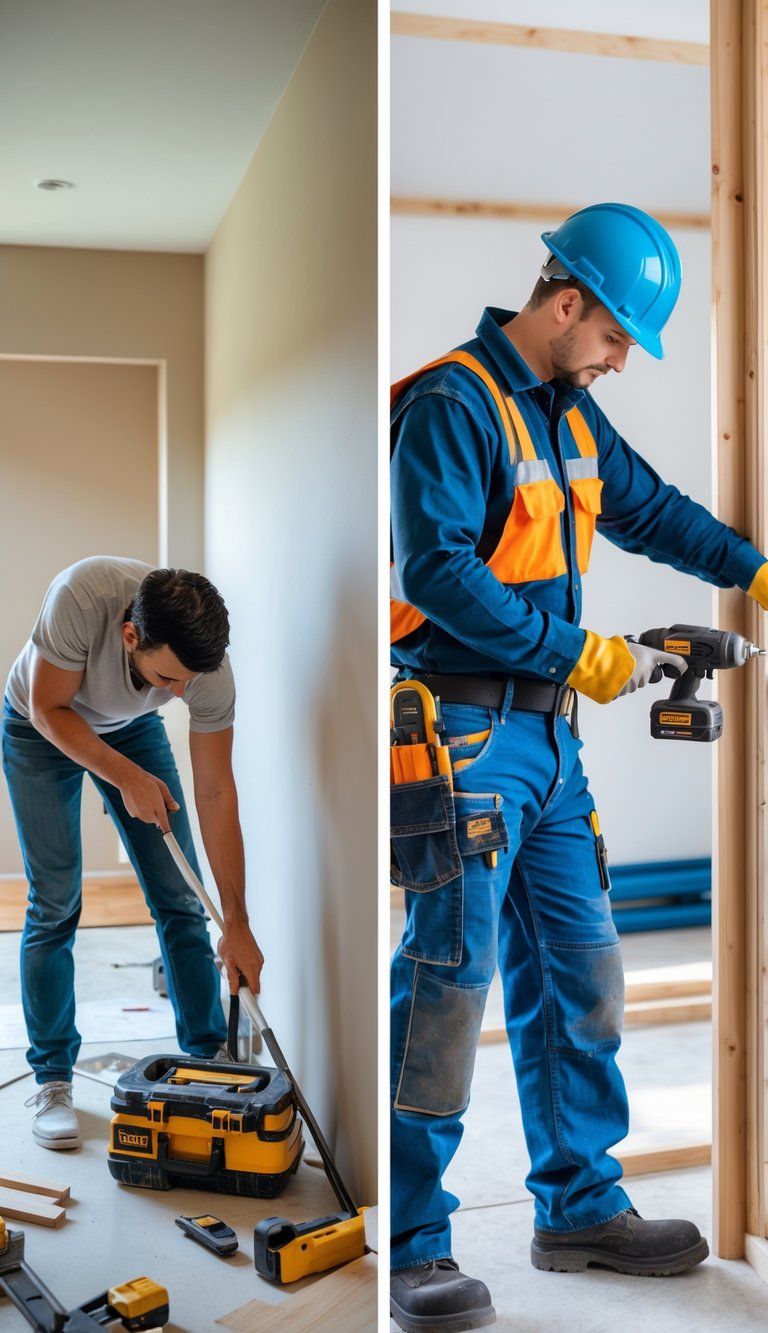
Some home projects really belong in the hands of professionals. Safety issues, technical challenges, and legal requirements make certain jobs way too risky for DIY. These projects need specialized knowledge and tools most of us just don’t have.
Electrical Work and Installing Light Fixtures
Electrical work can get dangerous fast. Fire hazards, electric shocks—it’s not worth the risk. You should call a licensed electrician for:
- Upgrading panels or adding new circuits
- Wiring up new rooms or additions
- Troubleshooting electrical problems that keep coming back
Swapping out a light fixture might look simple, but older homes often hide surprises like outdated wiring that doesn’t meet code.
Licensed electricians carry proper insurance and know local building codes inside and out. They’ll make sure your electrical work passes inspection, which is a big deal for your insurance and if you ever sell your place.
Paying for a pro ($50-150 per hour, usually) is nothing compared to a hospital bill, fire damage, or failing an inspection because of a DIY mistake.
Plumbing and HVAC Repairs
Plumbing and HVAC systems can be complicated. One little error could mean water damage or a furnace that doesn’t heat your house right.
You should call a plumber for:
- Installing new fixtures or appliances
- Stubborn leaks or clogs
- Low water pressure that won’t go away
- Anything that needs a permit
HVAC systems deal with refrigerants, and the law requires certification to handle those. Pros also know how to size units for your home, which is key for efficiency.
DIY HVAC repairs can void your warranty and cause even bigger headaches. Professionals show up with diagnostic tools to spot issues fast, instead of guessing.
If you mess up HVAC installation, you might end up with carbon monoxide leaks or mold from poor ventilation. That’s not something you want to risk.
Roofing and Roof Repairs
Roof work is risky and tough. Falls from roofs are one of the top causes of serious home improvement injuries. Professional roofers bring the right safety gear and know how to avoid accidents.
Quality roofing means:
- Picking materials that work for your climate
- Using proper installation techniques so water can’t sneak in
- Making sure there’s enough ventilation
- Understanding what kind of support your roof needs
Even a tiny leak can lead to major damage inside your house. Pros can spot early warning signs that most people miss.
Most roofing warranties also require professional installation. DIY repairs might seem cheaper, but if you mess up and get water damage, the costs can skyrocket.
Plus, roofers haul away old materials—something that’s a huge hassle if you try to do it yourself.
Structural and Code-Sensitive Renovations
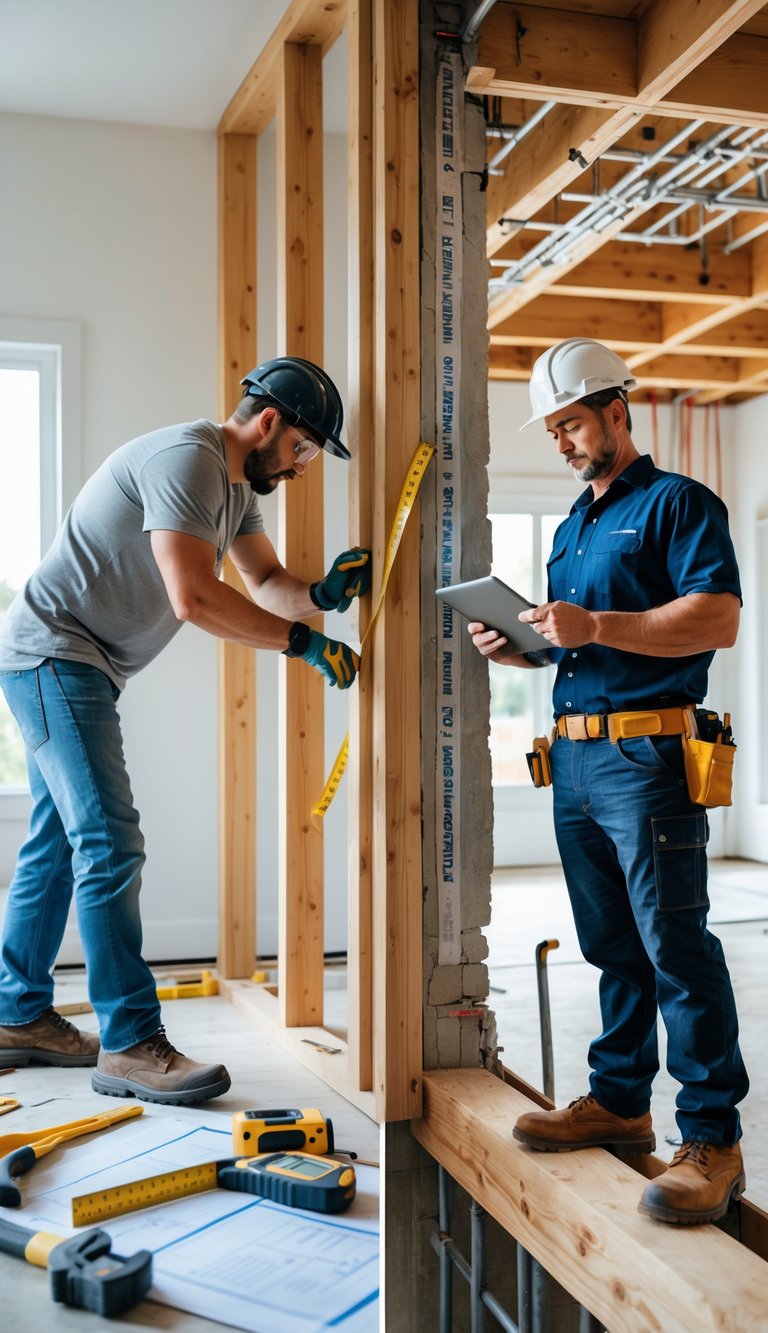
Some renovations demand a pro’s touch to keep your home safe and up to code. These projects usually involve your home’s core structure or have strict legal requirements.
Structural Work and Changes
Don’t try to remove or change walls on your own. These changes can mess with your home’s support system and create dangerous situations if you get it wrong. Professional contractors know how to spot load-bearing walls and understand the impact of changes.
They also have the right equipment and engineering know-how. If your project needs support beams, they can install them properly so your house stays strong.
Fixing bad structural work usually costs more than hiring a pro from the start. And let’s be honest—structural failures can cause injuries or worse.
Adhering to Local Building Codes
Building codes exist for a reason: your safety. These rules vary by area and cover everything from electrical work to plumbing and structural changes.
Contractors know these codes and when you need permits. They can handle the paperwork, which can be a real headache if you’re not used to it.
If you skip permits, you could face:
- Fines from the city
- Having to redo the work
- Trouble selling your house later
- Insurance headaches if something goes wrong
Pros also have connections with local inspectors and know what’s needed to pass the first time.
Kitchen Remodels and Major Home Renovations
Kitchen remodels are complicated. They often involve plumbing, electrical, and sometimes structural changes. Managing all these moving parts takes skill.
Contractors coordinate the work and make sure everything happens in the right order. They can spot problems before they get expensive.
For big renovations, you’ll get:
- More accurate time estimates (DIY can drag on for months)
- Warranties on the work
- Better prices or access to higher-quality materials
- Someone who can handle the unexpected
Sure, you’ll pay more upfront, but professional renovations usually add more value and help you avoid costly mistakes.
Safety, Convenience, and Other Considerations

When you’re deciding between DIY and hiring a pro, there’s more to think about than just cost. Your safety, your time, and how the finished project looks all matter.
Working at Heights and Specialized Risks
Safety has to come first. Working at heights—like on roofs or tall trees—brings real dangers. Falls are one of the most common reasons people end up in the ER after a home project.
You should call a professional for:
- Roof repairs or full replacements
- Electrical work, especially with the main panel
- Tree removal near power lines
- Jobs that need scaffolding
- Gas line installations or repairs
Pros have the right safety gear, ladders, and training to handle these risks. Their insurance covers accidents or damage, which you won’t get if you go DIY.
Convenience and Time Savings
Time is precious. Some projects eat up way more of it than you expect. A pro might finish in a day, while you could be stuck working weekends for a month.
Ask yourself:
- Do you really have time to finish this project?
- Will you lose access to a room while you work?
- Do you have space for all the tools and supplies?
Hiring a professional often means less disruption. They show up with everything they need, so you won’t be running to the store every hour.
A lot of us underestimate how long a project will take. What starts as a “quick weekend project” can easily turn into weeks of unfinished work if you’re learning as you go or only have evenings free.
Enhancing Curb Appeal with Professional Help
First impressions really do matter, especially when it comes to those exterior projects that shape your home’s curb appeal.
You can spot the difference when a pro handles the job—the finish just looks more polished, and it honestly bumps up your property’s value.
Areas where professional quality shows:
- Landscaping design and hardscaping
- Exterior painting and siding installation
- Front entry renovations
- Driveway and walkway installations
Professional landscapers know where to put plants, how they’ll grow, and what they’ll need to thrive.
They can pull off designs that keep your yard looking sharp all year.
If you’re thinking about exterior painting, pros bring clean lines and prep everything the right way.
They’ve seen it all, so they avoid rookie mistakes—no peeling paint, no weird streaks.
Let’s face it, when your home’s look influences the neighborhood vibe or future resale, sometimes it just makes sense to call in the experts.

